|
| |
Archives
my head is going to explode
The pressure building inside my head is not, at least at the moment, caused by the destructive actions of the Bushies but is actually from realizing what some of the creative possibilities are with some of the photography tools I'm acquiring.
The cause of this intense pressure was the the trade, for $17.15 worth of film and shipping, of a 5x7 view camera, probably a Burke and James.
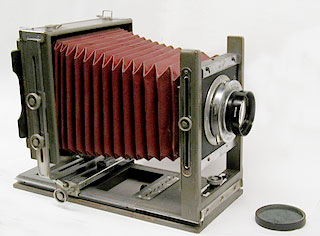
Since the trader is throwing in a 4x5 graflok back that I can modify into a reducing back for the 5x7, and with the Speed Graphic that I am refurbishing, I am set up in the large format department. Both cameras need some work but, when finished, they will give me 3.25x4.25, 4x5, and 5x7 formats.
The 3.25x4.25 and 4x5 formats are enlarging formats. While 5x7 is sometimes an enlarging format (talk about *big* enlargers), it is big enough for contact printing. And this is the direction that has me so excited. I swore that I would never print in a darkroom again. The digital controls you have in Photoshop let you do things impossible with an enlarger. But a 5x7 or 8x10 contact print is breathtaking. Literally.
Back in the early 1970s I took a fine art black and white printing class. We met once a week for instruction. Part of each class was to bring in a print for evaluation. I didn't have an enlarger when I started the class so I took an old Kodak 5x7 that I had as a display camera, slapped on one of my 4x5 lenses, made some exposures and contact printed one of them. On class day we showed up with our prints. Most in the class were shooting 35mm Tri-x and making 11x14 prints. After looking at several of the large prints with giant grain and very few tones, I sheepishly passed down my little 5x7 print. The instructor looked at it and let out an audible gasp. For sharpness and tonality, there is nothing like a large contact print.
Part of me has wanted to do large contact prints but that part had grown small with the advent of Photoshop. But recently I had, in my Internet explorations for information on developing black and white film for the Speed Graphic, come accross a old photographic paper designed for contact printing that gives incredible results — Azo. Michael Smith and Paula Chamlee use Azo and are dealers for Azo. Their site has lots of information on Azo. So I plan on contact printing the 5x7 negatives, new and old ones from the 1970s, on Azo. That means I need to build a small darkroom.
But wait! There's more! Contact printing Azo (just like Edward Weston) is exciting enough but then, in my googling, I stumbled on making digital negatives. I've known that printing digital negatives for alternative processes that use contact printing has been going on but I've not been one for some of the alternative processes. I guess I will be doing one of the alternative proccesses now. The idea is that you manipulate the image in Photoshop and then, instead of printing the picture on paper, you print the negative image on clear plastic and use that for contact printing. This combines the best of both worlds — digital darkroom and traditional wet darkroom. Dan Burkholder has written the book on this process. This will allow me to take negatives meant for enlarging and put them into photoshop for all the burning and dodging and whatall and then make straight contact prints at whatever size I want. Woo hoo!
Here is another link on contact printing with digital negatives...
Digital Negatives for Contact Silver Printing
|
Most of the shortcomings of the ink jet printer are overcome by printing a negative rather than a positive. Where the dots are sparse, silver clumps fill the area. Where the ink dots are dense, highlights in the print are rendered smoothly. With negatives made with the Epson Photo 1200 in color mode, the resulting silver gelatin prints are easily accepted as fine prints and can be expressively far superior to those made under an enlarger. The results are repeatable - all of the "dodging & burning" being done before the negative is made, and the final print shares the visual and archival traits associated with fine silver printing.
| |
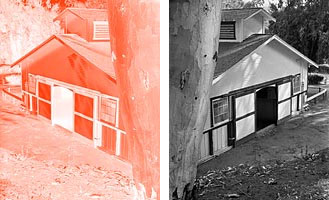
[more]
And an interview with Dan Burkholder...
Dan Burkholder
|
I was first introduced to Dan Burkholder's magnificent photographic work at a gallery in Washington, D.C. Stunned by his landscape images, I went on to find that Dan is also a virtuoso in several other styles or categories of image-making including his revolutionary "pigment-over-platinum" prints. Originator of the digital negative and author of the ground-breaking book Making Digital Negatives for Contact Printing, Dan is a true pioneer who has successfully bridged the gap between chemical and digital photography.
| |
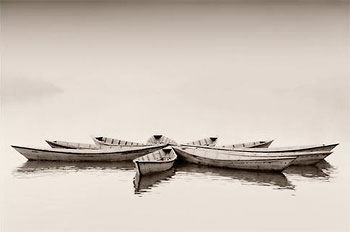
[more]
I like the idea of using film in antique cameras, scanning and processing the image digitally, and then using paper first introduced 100 years ago to the printing. I think my head just popped.
election 2004
Democrats to force House, Senate debate on Ohio election before Congress certifies Bush win
|
A small group of Democrats agreed Thursday to force House and Senate debates on Election Day problems in Ohio before letting Congress certify President Bush's win over Sen. John Kerry in November.
While Bush's victory is not in jeopardy, the Democratic challenge will force Congress to interrupt tallying the Electoral College vote, which had been scheduled to begin at 1 p.m. EST Thursday. It would be only the second time since 1877 that the House and Senate were forced into separate meetings to consider electoral votes.
Sen. Barbara Boxer, D-Calif., signed a challenge mounted by House Democrats to Ohio's 20 electoral votes, which put Bush over the top. By law, a protest signed by members of the House and Senate requires both chambers to meet separately for up to two hours to consider it. Lawmakers are allowed to speak for no more than five minutes each.
| |
[more]
iraq
Nelson
|
Ben Wikler provides us with a choice excerpt from the Nelson report, a long running insider tipsheet generally considered to be quite reliable:
There is rising concern amongst senior officials that President Bush does not grasp the increasingly grim reality of the security situation in Iraq because he refuses to listen to that type of information. Our sources say that attempts to brief Bush on various grim realities have been personally rebuffed by the President, who actually says that he does not want to hear "bad news."
Rather, Bush makes clear that all he wants are progress reports, where they exist, and those facts which seem to support his declared mission in Iraq...building democracy. "That's all he wants to hear about," we have been told. So "in" are the latest totals on school openings, and "out" are reports from senior US military commanders (and those intelligence experts still on the job) that they see an insurgency becoming increasingly effective, and their projection that "it will just get worse."
Our sources are firm in that they conclude this "good news only" directive comes from Bush himself; that is, it is not a trap or cocoon thrown around the President by National Security Advisor Rice, Vice President Cheney, and DOD Secretary Rumsfeld. In any event, whether self-imposed, or due to manipulation by irresponsible subordinates, the information/intelligence vacuum at the highest levels of the White House increasingly frightens those officials interested in objective assessment, and not just selling a political message.
| |
[more]
New Year and Elections...
by Riverbend
|
We spent New Year at home (like last year). It was a very small family gathering and E. and I tried to make it as festive as possible, under the circumstances. We agreed, amongst ourselves in the area, to have the generator turned on from 10 pm until 2 am so we could ride out 2004 on a wave of electricity.
The good part of the evening consisted of food. Food is such a central issue for an Iraqi occasion- be it happy or sad. We end up discussing the food before anything else. For us, it was just some traditional Iraqi food and some junk food like pop-corn, corn chips, and lots of candy.
We sat watching celebrations from different parts of the world. Seeing the fireworks, lights, droves of laughing and singing people really emphasizes our current situation. It feels like we are kind of standing still while the world is passing us by. It really is difficult to believe that come April, two years will have passed on the war and occupation. On most days, an hour feels like ten and yet, at the same time, it becomes increasingly difficult to get a good sense of passing time. I guess that is because we measure time with development and since things seem to be deteriorating in many ways, it feels almost as if we're going backwards, not forwards.
| |
[more]
Iraqi insurgents now outnumber coalition forces
|
IRAQ’S rapidly swelling insurgency numbers 200,000 fighters and active supporters and outnumbers the United States-led coalition forces, the head of the country’s intelligence service said yesterday.
The number is far higher than the US military has so far admitted and paints a much grimmer picture of the challenge facing the Iraqi authorities and their British and American backers as elections loom in four weeks.
| |
[more]
thanks to Antiwar.com
The Jungle in the Desert
We Never Learned Why We Lost the Vietnam War, and Now We're Losing Another Asian War
|
The U.S. war planners underestimated the Iraqis’ will to resist and they underestimated the insurgents’ ability to develop a wartime strategy. After “shock and awe,” the resistance would surely be reduced to a “rag-tag resistance,” right? The planners overestimated the U.S. military’s technology and firepower, which they always do. Twenty-one months into this war, the world’s most powerful military is stymied, unable to halt the expanding Iraqis insurgency and the rising number of American dead.
Those who planned this war knew as much about Iraq as those who planned the Vietnam War knew about Vietnam, which is why Iraq will end as Vietnam ended. In America's defeat.
For those of us who fought in Vietnam and reflected on that disastrous war, we knew America could not win in Iraq. Many Americans came to that conclusion without having served in Vietnam. But not the Bush Administration and the Neocons, and not most Americans, who went along with the invasion and occupation of Iraq. For these Americans, the Vietnam War never happened and Iraq would be “fast and easy.”
The Canadian asked, in reference to the Vietnam War, “What was that war all about anyway?”
Major Wilson said, the Iraq War planners had “stunted learning.”
And now retired Army General Donald Shepperd, speaking on CNN, says: “It doesn’t look like there is light at the end of the tunnel.”
Yes, the Iraq tunnel is dark. Very dark. As dark as the Vietnam tunnel was dark.
| |
[more]
A Vietnam Grunt Looks at Iraq
|
It is as if I am in a nightmare that never ends. The nightmare is about Vietnam, but it is also about Iraq and Afghanistan. I seem to be in a time warp, and over and over every day and night I see not Iraq, but Vietnam. I see the same kids dying the same way all over again. I see the distance between the reality of the war and the American people. I hear the same lies. I see the same callous disregard for the troops in the midst of the battles. It is not a nightmare I experience; it is terribly real.
| |
[more]
You called my mother a bitch? Ok. Now you die.
|
How bad is it that the US has shitty intelligence in Iraq? Well, until 2003, informing was an industry. People sold out others for money like it was a job, and many cases it was. Well, it seems informers have standards and they won't do the same for the Americans. If Zarqawi is alive, he's got a trail like a snail. He's got bodyguards and trucks. He should be easy to spot. He isn't. Why? Because they would rather tolerate his nutjobness than the Americans. The guerrillas blew up a house which killed 28 people. Normally, people who do that would be hunted down like dogs for playing with their lives like that. Or someone would have warned the police. Neither happened. Why? Because they hate the Americans just that much.
| |
[more]
"The supreme international crime"
|
Excerpt from the Judgment of the Nuremberg Tribunal relating to "Count Two", the Crime of Aggression, as brought against Goering, Ribbentrop, and 14 other defendants:
The charges in the Indictment that the defendants planned and waged aggressive wars are charges of the utmost gravity. War is essentially an evil thing. Its consequences are not confined to the belligerent states alone, but affect the whole world.
To initiate a war of aggression, therefore, is not only an international crime; it is the supreme international crime differing only from other war crimes in that it contains within itself the accumulated evil of the whole.
Nicholas J. S. Davies, a Contributing Writer over at Online Journal posted a generally well-argued piece there on December 31, in which he reviewed the history in international jurisprudence of the crime of initiating an aggressive war, and concluded that the US and British governments were guilty of such a crime in initiating the war against Iraq.
| |
[more]
photography
Joerg brings us a tasty selection of links from the hip Master of Square — Irving Penn
Irving Penn

[more]
Irving Penn, A Career in Photography
IRVING PENN, 1917 - 2004
Earthly Bodies: Irving Penn's Nudes, 1949–50

Elections Without Democracy
Only Candidates Acceptable to the Occupier Need Apply
|
During the 1970's, the apartheid government of South Africa sought to bolster its claims to legitimacy by allowing elections in the Bantustans - the equivalent to today's walled in Palestinian communities in the West Bank and Gaza Strip. The thought was that if people elected local officials, even to hold largely ceremonial offices, then the rest of the world would stop whining about how undemocratic and illegal apartheid was.
There were two problems with this strategy. First, the world understood that ceremonial elections do not make a democracy. Second, the major candidate in any election that would be endorsed by black South Africans-Nelson Mandela-was being held in a South African prison. Instead, black South Africans were being offered collaborator candidates that were chosen by the white South African government.
Through its policy of "constructive engagement," however, the Reagan administration tacitly endorsed this strategy, even when Congress resisted by passing the Anti-Apartheid Act in 1986.
How little has changed. Except for the lack of Congressional resistance, the situation in the Israeli-occupied territories mirrors that of apartheid South Africa. Palestinians are being forced, either by choice or fate, to agree to "acceptable" candidates for elections to offices that will have only as much power as the Israeli government, underwritten by the Bush administration, grants.
| |
[more]
thanks to Aron's Israel Peace Weblog
photography
Avedon's final take
For 60 years, Richard Avedon's work amazed the world. But nobody knew his portraits of American soldiers who fought in Iraq would be his last. His assistant, Laura Wilson, captured his final moments
|
As we piled into the van at 8:30pm and headed up Interstate 80, one of the world's most famous photographers, now 81, was making his third three-hour trip between Reno and Winnemucca that day. It was September 18, 2004. "We're off to Maine!" he said, anticipating the bright prospects of a road trip. This is what he always said over the 25 or so years I had known him. It referred to his childhood in New York City, when his family, on special occasions, would borrow a car and pretend to be setting off, like the richest of the rich, for their summer holiday.
| |
[more]
thanks to The Analog Photography Users Group
big pharma
Intimidation, Politics and Drug Industry Cripple U.S. Medicine
|
While the U.S. Food and Drug Administration (FDA) is supposed to safeguard the nation's medical products, drawing upon the substantive expertise of its drug scientists in vigilant dedication to the public's health, that is not the case today.
Documentation, interviews and recent drug debacles depict a brutally different reality, with the Vioxx scandal alone estimated to have resulted in 30,000-55,000 U.S. deaths.
"You have an agency in denial -- the FDA still maintains it made no mistake in the approval or regulation of Vioxx," says the agency's associate safety director, Dr David J Graham.
| |
[more]
ad art
Fading Ad Gallery
|
GHOST SIGNS, GHOST ADS, PHANTOMS, VINTAGE MURAL ADVERTISEMENTS, WHATEVER YOU CALL THEM- FADING ADS ARE METAPHORS FOR SURVIVAL
| |
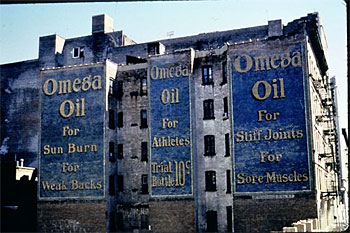
[more]
blue companies
ChooseTheBlue!
|
ChooseTheBlue.com compiles information from third party sources primarily to show certain reported spending by political action committees connected with a corporation and by that corporation's employees as political contributions, in each case related to recent federal elections.
| |
[more]
thanks to daily KOS
panos
A great site with many spectacular panoramics of Paris, and more.
from PARIS

[more]
oil
Drilling for Value
The analyst oil barons consult on where to make money at today's high energy prices
|
Saudi Arabia more or less managed to market its oil around the $25-a-barrel level for as long as it could. The big event of 2004 is that the oil market called Saudi Arabia's bluff. They couldn't deliver the spare capacity they said they had. It turns out they have spare capacity, but it is in heavy oil, not light oil, which is easy to refine and doesn't have much sulphur in it. It's also known as "light sweet" crude, and it produces more gasoline and more heating oil. So 2004 was the year in which the world production of light oil peaked. There are no big fields of light oil producing now that can produce more. Saudi Arabia has heavy oil to sell, but they have to discount it much more. If Saudi Arabia could have produced more light oil, they would have.
| |
[more]
thanks to The Mike Runge Peak Oil Archive
photography
The Northern Great Plains, 1880-1920
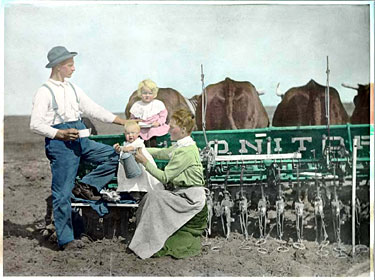
Oxen pulling a grain drill in pioneer days : a welcome break in a long day, stopping for lunch and a chat with mom and the youngsters.
[more]
thanks to plep
agriculture
U.S. ag export surplus evaporates
|
For nearly two years, U.S. farmers and ranchers watched as the second shoe grew bigger and bigger.
On Nov. 22, it officially dropped. According to U.S. Department of Agriculture Economic Research Service estimates released that day, 2005 will be the first year in nearly 50 that America will not turn an agricultural trade surplus.
The dubious milestone was met with odd silence at USDA. Odd because throughout the fall presidential campaign, Secretary of Agriculture Ann Veneman talked herself hoarse each time some farm community in a swing state dedicated a new USDA-sponsored street light.
Now, as America is about to become a net food importer for the first time in generations, Veneman has no explanation of how Bush Administration economic and trade policies have taken American agriculture from a $13.6 billion trade surplus in 2001 to a flat line in four short years.
Who can blame her. Would you want to be the first secretary of the last 11 to report such death-in-the-family news?
| |
[more]
thanks to Bad Attitudes
photography
Bruce Jackson
Mirrors
|
These images are based on a group of about two hundred 3x4" identification photographs made between 1914 and 1937 that I found in a drawer in the Arkansas penitentiary in the summer of 1975. The photographs of the men were loose in the drawer; the photographs of the women—all of them white— were in a small brown envelope. Most of the photographs of the men were taken inside, against a wall or a cloth; most of the photographs of the women were taken outside, near a fence, in a wicker chair.
| |
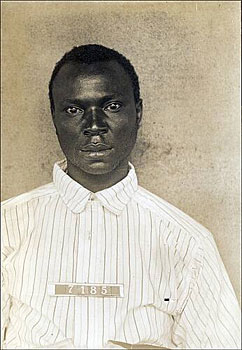
[more]
thanks to plep
social security
Stopping the Bum's Rush
by Paul Krugman
|
The people who hustled America into a tax cut to eliminate an imaginary budget surplus and a war to eliminate imaginary weapons are now trying another bum's rush. If they succeed, we will do nothing about the real fiscal threat and will instead dismantle Social Security, a program that is in much better financial shape than the rest of the federal government.
In the next few weeks, I'll explain why privatization will fatally undermine Social Security, and suggest steps to strengthen the program. I'll also talk about the much more urgent fiscal problems the administration hopes you won't notice while it scares you about Social Security.
Today let's focus on one piece of those scare tactics: the claim that Social Security faces an imminent crisis.
That claim is simply false. Yet much of the press has reported the falsehood as a fact. For example, The Washington Post recently described 2018, when benefit payments are projected to exceed payroll tax revenues, as a "day of reckoning."
Here's the truth: by law, Social Security has a budget independent of the rest of the U.S. government. That budget is currently running a surplus, thanks to an increase in the payroll tax two decades ago. As a result, Social Security has a large and growing trust fund.
| |
[more]
photography
LOOKING AT WAR
by Susan Sontag
|
In the first important wars of which there are accounts by photographers, the Crimean War and the American Civil War, and in every other war until the First World War, combat itself was beyond the camera’s ken. As for the war photographs published between 1914 and 1918, nearly all anonymous, they were—insofar as they did convey something of the terrors and devastation endured—generally in the epic mode, and were usually depictions of an aftermath: corpse-strewn or lunar landscapes left by trench warfare; gutted French villages the war had passed through. The photographic monitoring of war as we know it had to wait for a radical upgrade of professional equipment: lightweight cameras, such as the Leica, using 35-mm. film that could be exposed thirty-six times before the camera needed to be reloaded. The Spanish Civil War was the first war to be witnessed (“covered”) in the modern sense: by a corps of professional photographers at the lines of military engagement and in the towns under bombardment, whose work was immediately seen in newspapers and magazines in Spain and abroad. Pictures could be taken in the thick of battle, military censorship permitting, and civilian victims and exhausted, begrimed soldiers studied up close. The war America waged in Vietnam, the first to be witnessed day after day by television cameras, introduced the home front to a new intimacy with death and destruction. Ever since, battles and massacres filmed as they unfold have been a routine ingredient of the ceaseless flow of domestic, small-screen entertainment. Creating a perch for a particular conflict in the consciousness of viewers exposed to dramas from everywhere requires the daily diffusion and rediffusion of snippets of footage about the conflict. The understanding of war among people who have not experienced war is now chiefly a product of the impact of these images.
| |
[more]
they want to come for you
Headin' for the big roundup
|
Having made two post-election jaunts to the red state hinterlands of Idaho and Montana, I'm back to report that, well, things are getting ugly out there. In some cases, really ugly.
I've been talking for some time about the course that eliminationist rhetoric on the right would eventually take by the force of its own nature: pretty soon we'd go from talking about liberals as traitors to overtly wishing for violence to be visited upon them and discussing locking them up, followed in due course by such violence and incarceration becoming a reality.
Well, it is now becoming a commonly spoken sentiment on the right to wish for violence against liberals and to simultaneously suggest they and all "traitors" (including Muslim Americans) should be locked away. We're firmly into Phase II now.
| |
[more]
comics
One of the great comic artists has died.
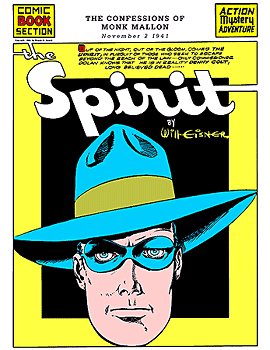
Will Eisner, a Pioneer of Comic Books, Dies at 87
|
Will Eisner, an innovative comic-book artist who created the Spirit, a hero without superpowers, and the first modern graphic novel, "A Contract With God," died on Monday in Fort Lauderdale, Fla., where he lived. He was 87.
| |
[more]
Will Eisner Made Fighting Bigotry An Art Form
|
In addition to having the hand and eye of a gifted artist, Will Eisner, who died Monday at 87, had an amazing insight into the human condition and the heart of a true club boxer. He was tough, game and always moving, packed a powerful punch and never quit.
| |
[more]
Will Eisner, RIP (1917-2005)
|
Will Eisner passed away on January 3rd, 2005 at the age of 87 following quadruple bypass heart surgery.
| |
[more]
my sister says my vacation has gone on long enough and i need to get back to work
So I'm back at work posting for my insatiable readers. Both of them.
My son-in-law, William, arrived from Ramadi New Year's Eve. We had Christmas with my kids and grandkids New Year's Day. It was great to see William again. Jenny says he is adjusting too well. He goes back the 14th or 15th until August.
I've been doing some testing with my Flexaret IIIa. It's definitely sharper than the Pearl River. I still want a Flexaret V but the one in this weeks eBay auction from Cupog went a little high. Now I'm short money. He has them regularly so there will be one in my future. In the meantime I picked up some more black and white filters for the Flexaret from Cupog.
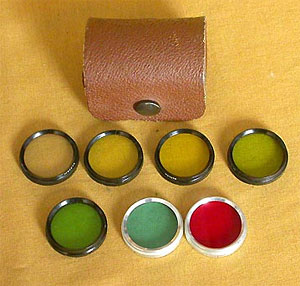
With the ones that came with my Flexaret III, I have a compete set. Woo hoo!
The big score happened today. I was cruising the posts at Rangefinder Forum when I find one of the members wanted to trade a 5x7 view camera for some film. We exchanged messages during the day and agreed on 5 rolls of Fuji NPS 135-36 which, with shipping from B&H, comes to $17.90.

"The camera has a run-of-the-mill Elgeet 10" f4.5-45 lens in an alphax shutter. The shutter is probably the best thing about it as it has T and B modes as well as X and M flash sync's. The camera is in really used shape with plenty of wear and mismatched screws and the name tag fell off years ago, so I don't remember who made it."
And he is throwing in a 4x5 Graflock back without ground glass that I can use to build a 4x5 reducing back. It looks like it might be a Burke and James "tailboard" which means the rear standard does the focusing. Simple but it works.
Any 4x5s I would scan but the 5x7s I want to contact print on Azo. I swore I would never print in a darkroom again but I have always wanted to make contact prints and this might be interesting. I have a bunch of 5x7 negs I made in the 70s that would make nice contact prints, too. Another project. That's all I need.
Update: It only came to $17.15 including shipping.
|
|
|
|












